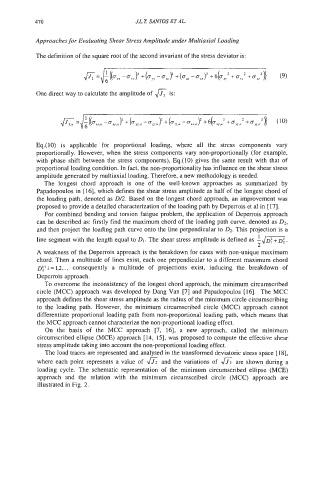Page 486 - Biaxial Multiaxial Fatigue and Fracture
P. 486
470 J.L.7: SANTOS ET AL.
Approaches for Evaluating Shear Stress Amplitude under Multiaxial Loading
The definition of the square root of the second invariant of the stress deviator is:
1
&&{(rXx -6,,)2 +(e,, -crr)2 +(6, -6,)* +6(c,,' +err2] (9)
One direct way to calculate the amplitude of is:
Eq.(lO) is applicable for proportional loading, where all the stress components vary
proportionally. However, when the stress components vary non-proportionally (for example,
with phase shift between the stress components), Eq.(lO) gives the same result with that of
proportional loading condition. In fact, the non-proportionality has influence on the shear stress
amplitude generated by multiaxial loading. Therefore, a new methodology is needed.
The longest chord approach is one of the well-known approaches as summarized by
Papadopoulos in [16], which defines the shear stress amplitude as half of the longest chord of
the loading path, denoted as D/2. Based on the longest chord approach, an improvement was
proposed to provide a detailed characterization of the loading path by Deperrois et al in [ 171.
For combined bending and torsion fatigue problem, the application of Deperrois approach
can be described as: firstly find the maximum chord of the loading path curve, denoted as 4,
and then project the loading path curve onto the line perpendicular to D2. This projection is a
line segment with the length equal to DI. The shear stress amplitude is defined as !-,/=.
2
A weakness of the Deperrois approach is the breakdown for cases with non-unique maximum
chord. Then a multitude of lines exist, each one perpendicular to a different maximum chord
oy) i = 1,2 ... , consequently a multitude of projections exist, inducing the breakdown of
Deperrois approach.
To overcome the inconsistency of the longest chord approach, the minimum circumscribed
circle (MCC) approach was developed by Dang Van [7] and Papadopoulos [16]. The MCC
approach defines the shear stress amplitude as the radius of the minimum circle circumscribing
to the loading path. However, the minimum circumscribed circle (MCC) approach cannot
differentiate proportional loading path from non-proportional loading path, which means that
the MCC approach cannot characterize the non-proportional loading effect.
On the basis of the MCC approach [7, 161, a new approach, called the minimum
circumscribed ellipse (MCE) approach [14, 151, was proposed to compute the effective shear
stress amplitude taking into account the non-proportional loading effect.
The load traces are represented and analysed in the transformed deviatoric stress space [ 181,
where each point represents a value of fi and the variations of are shown during a
loading cycle. The schematic representation of the minimum circumscribed ellipse (MCE)
approach and the relation with the minimum circumscribed circle (MCC) approach are
illustrated in Fig. 2.

